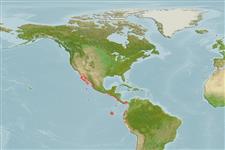>
Beloniformes (Needle fishes) >
Belonidae (Needlefishes)
Etymology: Strongylura: Greek, strongylos = round + Greek, oura = tail (Ref. 45335).
More on author: Girard.
Environment: milieu / climate zone / depth range / distribution range
Ökologie
seewasser; süßwasser; brackwasser; tiefenbereich 0 - 100 m (Ref. 96339). Subtropical; 33°N - 15°S, 118°W - 11°W (Ref. 56981)
Eastern Pacific: San Francisco in California, USA to Peru, including the Galapagos Islands.
Size / Gewicht / Alter
Maturity: Lm ? range ? - ? cm
Max length : 91.0 cm TL Männchen/unbestimmt; (Ref. 2850); common length : 50.0 cm SL Männchen/unbestimmt; (Ref. 9279)
Rückenflossenstacheln (insgesamt): 0; Rückenflossenweichstrahlen (insgesamt): 13-17; Afterflossenstacheln 0; Afterflossenweichstrahlen: 16 - 19; Wirbelzahl: 67 - 74. Caudal fin emarginate (Ref. 9279). Branchiostegal rays: 11-12 (Ref. 36575).
Common in coastal and lagoon areas with mangroves (Ref. 9279). Also found in bays and harbors (Ref. 36575). Penetrate fresh water (Ref. 9279). Adults occur in small schools. Feed mainly on small fishes (Ref. 9279). Oviparous, with neustonic larvae (Ref. 36575). Eggs are attached to vegetation and floating objects via long filaments (Ref. 36575). Usually caught with the help of artificial lights (Ref. 9279). Marketed fresh (Ref. 9279).
Life cycle and mating behavior
Geschlechtsreife | Fortpflanzung | Ablaichen | Eier | Fecundity | Larven
Eschmeyer, W.N., E.S. Herald and H. Hammann, 1983. A field guide to Pacific coast fishes of North America. Boston (MA, USA): Houghton Mifflin Company. xii+336 p. (Ref. 2850)
IUCN Rote Liste Status (Ref. 130435)
Bedrohung für Menschen
Harmless
Nutzung durch Menschen
Fischereien: weniger kommerziell
Mehr Information
ReferenzenAquakulturAquakultur ProfilZuchtlinienGenetikElectrophoresesVererbbarkeitKrankheitenVerarbeitungNutrientsMass conversion
PartnerBilderStamps, Coins Misc.LauteCiguateraGeschwindigkeitSchwimmstilKiemenoberflächeOtolithsGehirngrößeSehfähigkeit
Tools
Zusatzinformationen
Download XML
Internet Quellen
Estimates based on models
Preferred temperature (Ref.
123201): 17.7 - 28.9, mean 25.1 °C (based on 124 cells).
Phylogenetic diversity index (Ref.
82804): PD
50 = 0.5001 [Uniqueness, from 0.5 = low to 2.0 = high].
Bayesian length-weight: a=0.00126 (0.00055 - 0.00288), b=3.10 (2.92 - 3.28), in cm total length, based on LWR estimates for this Genus-body shape (Ref.
93245).
Trophic level (Ref.
69278): 4.5 ±0.80 se; based on food items.
Widerstandsfähigkeit (Ref.
120179): mittel, Verdopplung der Population dauert 1,4 - 4,4 Jahre. (Preliminary K or Fecundity.).
Fishing Vulnerability (Ref.
59153): High vulnerability (56 of 100).
Nutrients (Ref.
124155): Calcium = 86.8 [29.5, 278.3] mg/100g; Iron = 0.994 [0.485, 2.258] mg/100g; Protein = 17.7 [15.8, 19.7] %; Omega3 = 0.41 [0.18, 1.13] g/100g; Selenium = 26.2 [12.7, 52.8] μg/100g; VitaminA = 22 [7, 84] μg/100g; Zinc = 0.624 [0.422, 0.943] mg/100g (wet weight);
